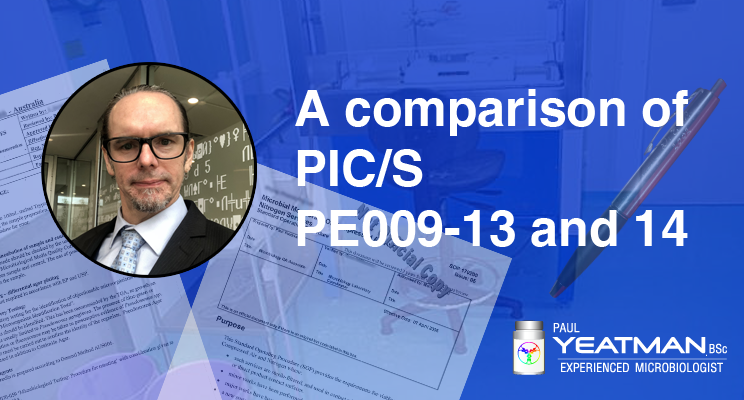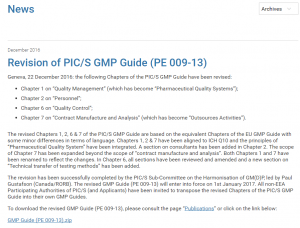Introduction
The PIC/S Guide to Good Manufacturing Practice PE009-13 was published January 1, 2017. Edition 14 was published on 1 July, 2018.
The TGA adopted version 13 of the guide in 2018 and “just given” notice that it intends to adopt the current version of the PIC/S Guide (PE009-14) by July 1st 2020.
So you know what changes, if any you need to make to be in compliance with PE009-14, what are the key differences between these two guidance documents?
According to the Revision History the following content was revised:
- Chapter 3 – Premises and Equipment
- Chapter 5 – Production
- Chapter 8 (Part 1) – Complaints and Product Recall
- Annex 17 – Parametric Release
Where possible I will compare the changes. For wholesale rewrites, I will summarise the new content.
Chapter 3 – Premises and Equipment
Section 3.6 has been rewritten to categorically state that cross-contamination should be prevented for all products. A risk based approach to using dedicated facilities is advised. Specifically drawing attention to the various product classes such as cytotoxics, sensitising materials, hormones etc has been dropped.
I’d like to see a line break between the end pf 3.19 and the start of 3.20.
Chapter 5 – Production
Section 5.17 has been moved from General into Prevention of Cross-Contamination in Production and expanded. A reference to Chapter 3 is included and attention is drawn to technical poisons.
Section 5.19 has been reworded and condensed. Chapter 3 is referenced.
Section 5.20. has been greatly expanded to include a discussion of risk assessment.
A new section 5.21 has been added outlining Organisational and Technical measures to prevent cross contamination with regards to Quality Risk Management. The information here comes from PE009-13’s section 5.19 and is more complete.
Section 5.22 is new and advises regular review section 5.17 to 5.21.
The sub chapters on Starting Materials, previously included Section 5.25 to 5.35. These have been expanded and now comprise sections 5.27 to 5.39. New guidelines relating to risk assessments and supporting evidence has been included.
Section 5.29 introduces information on the approval and maintenance of suppliers of active substances.
Section 5.33 (the old 5.30) drops reference to Chapter 6, Item 13 and states solely Chapter 6. Item 13 relates to sample container labelling in PE009-13 and 14.
Section 5.35 is new and discusses who is responsible for the testing of starting materials.
Section 5.36 is new and discusses the rationale for outsourcing. Importantly, this needs to be documented and justified.
Section 5.32 now becomes section 5.37.
Section 5.42 under Processing Operations Intermediate and Bulk Products (previously 2.37) no longer has “validation “in bold. I would suggest this in no way deemphasises the need for validation.
Section 5.45 in Packaging Materials (previously 5.40) has been reworded from the purchase of materials to the selection, qualification and maintenance of suppliers of such materials.
Section 5.53 (previously 5.48) now states attention should be given to “avoid and remove” rather than “avoiding and removing” contaminants.
Section 5.59 (previously 5.54) now has the five bullets numbers rather than alphabetised.
Section 5.7 (previously 5.65) has not changed with regards to return of product from the market. The resale or recovery of such product can only be assessed by the Quality Control Department, so NOT the Quality Assurance Department. Presumably the investigation would be conducted by QC representatives and ultimately signed off on by QA.
A new sub chapter Product Shortage due to Manufacturing Constraints has been included with a single section, 5.71 discussing the need to report this in a timely manner to the marketing authorisation holder (MAH) is there is going to be a restriction of supply.
Chapter 8 (Part 1) – Complaints and Product Recall
The entirety of Chapter 8 has been greatly expanded. I recommend you read the updated guidance in detail.
Previously there were three sub chapters:
- Principle
- Complaints
- Recalls
Now there are six:
- Principle
- Personnel and Organisation
- Procedures for Handling and Investigating Complaints Including Possible Quality Defects
- Investigation and Decision-Making
- Root Cause Analysis and Corrective and Preventative Actions
- Product Recalls and Other Potential Risk-Reducing Actions
Rather than compare version 13 to 14, I will summarise what is in the version 14 Chapter 8.
Chapter 8 – Principle Summary
The Principle has been greatly expanded. CAPA is now spelled out and reference given to Chapter 1. The need to inform the Competent Authorities in a timely manner has been added. Information on what happens when activities are outsources has been added.
Chapter 8 – Personnel and Organisation Summary
Appropriately trained, experienced and independent (from sales and marketing authorisation, unless justified) personal need to be responsible for investigating product complaints and quality defect investigations.
Sufficient resources needs to be allocated to this and they need to be available for interaction with the Competent Authorities.
Everything needs to be documented.
Chapter 8 – Procedures for Handling and Investigating Complaints Including Possible Quality Defects Summary
Document everything. Determine if the complaint is legitimate. Procedures need to be in place to document how to run an investigation. Section 8.9 details what points need addressing as part of the investigation.
Chapter 8 – Investigation and Decision-Making Summary
Document everything. Consider examining related batches (and possibly) products. Review previous defect reports. Make decisions based on risk and do this in a timely manner. Report quality defects to the Competent Authorities in a timely manner.
Chapter 8 – Root Cause Analysis and Corrective and Preventative Actions Summary
Where a root cause cannot be identified, hypothesise what it might be and address that. The effectiveness of CAPA needs to be monitored and assesses. Quality defect records need to be reviewed and trends analysed.
Chapter 8 – Product Recalls and Other Potential Risk-Reducing Actions Summary
Document everything. If the product is on the market, any return needs to be conducted as a recall and this needs to be conducted promptly and at the drop of a hat. If the recall affects clinical trials, the ability to identify blinded product (if necessary).
Consider discussing with the Competent Authorities the extent of the recall and they need to be informed BEFORE the recall is initiated.
Recalled products need to be stored back on site separately to other batches. The recalled batch needs to be reconciled to capture every vial, packet etc.
The recall procedure needs to be periodically evaluated for effectiveness. Here you could incorporate mock recalls into your internal audit program.
Annex 17 – Real Time Release Testing and Parametric Release
Previously names Parametric Release and containing items 1.1 to 3.17 (not including the Glossary, the sections now comprise 1.1 to 4.18 with the Glossary now being Section 5 (previously 4).
I recommend you read the updated Annex in detail.
The old sections were:
- Principle
- Parametric Release
- Parametric Release for Sterile Products
- Glossary
The new sections are:
- Principle
- Scope
- Real Time Release Testing (RTRT)
- Parametric Release and Sterilisation
- Sterilisation Process sub section 4.12 to 4.18
- Glossary
Rather than compare version 13 to 14, I will summarise what is in the version 14 Annex 17.
Annex 17 Principle Summary
Reference to the European Organization for Quality and a need to comply with the basic requirements of GMP has been dropped. Now it states that product must comply with their approved specifications and reference is made to the Pharmaceutical Quality System (PQS).
Annex 17 Scope Summary
The scope outlines the requirements for Real Time Release Testing.
Annex 17 Real Time Release Testing (RTRT) Summary
What RTRT entails is explained and advice is provided on designing a RTRT strategy. The RTRT strategy needs to be incorporated into the PQS. Reference to Part 1, Chaper 1 and Part II Chapter 2 of the PIC/S Guide to Good Manufacturing Practice for Medicinal Products is provided. References to Annex 13 and 15 is also provided.
As well as controlling the process, manufacturers need to ensure a state of control in maintained.
Staff need specific training in RTRT. Key personal need to be adequately experienced and have sufficient knowledge and understanding of RTRT.
Emphasis is given to qualification, validation and management.
All deviations or failures need to be thoroughly investigated and adverse trends identified and examined.
Where RTRT has been approved, that approach should be routine.
Annex 17 Parametric Release and Sterilisation Summary
Here the release of a batch that has been terminally sterilised is discussed.
A distinction between in process monitoring vs examining a terminally sterilised sample is given to draw attention to what end-product test here is capable of showing compared to in process testing.
A product cannot be moved to another container following terminal sterilisation.
This process can only be used with a suitable history of GMP compliance.
Everything needs to be documented and everyone needs to be appropriately qualified.
Change control is needed for changes.
Advice on bioburden testing is provided along with ways to reduce bio-burden in the product. Hold time validation (or at least consideration) is alluded to.
Sterilisation Process 4.12-4.18.
Qualification and validation are deemed critical and periodic requalification and revalidation should be planned. (Make sure you do it, not just plan to do it!) Routine monitoring is needed to show the sterilisation is effective. The steriliser trace should show all conditions were met for the cycle.
Non-compliance cannot be overrules by a finished product passing the test for sterility.
Annex 17 Glossary Summary
Revamped so rather than two sections, “Parametric Release” and “Sterility Assurance System” the Glossary now comprises:
- Control Strategy
- Critical Process Parameters
- Critical Quality Attributes
- Parametric Release
- Real time release testing
- State of Control
Conclusion
Chapter 3 introduced a risk based approach to segregation of product classes/categories.
Chapter 5 presents a greater emphasis Quality Risk Management especially with the new 5.21 sub section.
Chapter 8 was greatly expanded to detail corrective and preventative action, who does what (and what department they should be from), the need to inform the Competent Authorities in a timely manner and to conduct risk assessments.
Annex 17 Real Time Release Testing and Parametric Release was overhauled with a large discussion of the ins and outs of this form or release.
In addition to determining what changes you may need to make, you should check to see that you comply with the sections of the guidance that have not been revised. If you do not conduct such reviews regularly, I recommend doing this at least every year at a high level as part of your internal audit program. I also recommend that you review the guidance when updating or reviewing your documentation.
Paul Yeatman BSc 07/05/2020
I also reproduced this discussion on LinkedIn.
Did you find this informative or useful? Please consider a small donation so I can expand and improve on what I deliver.
![]()



